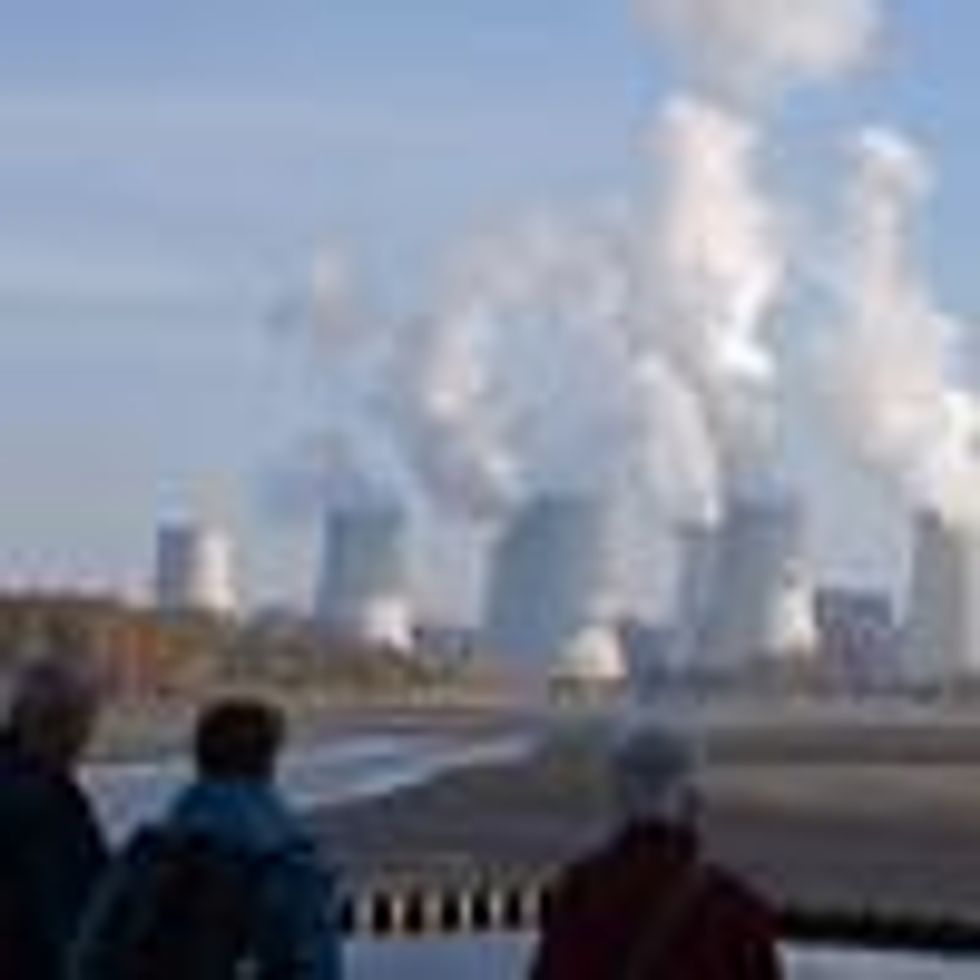
Flames are visible from a flaring pit near a well in the Bakken Oil Field. (Photo: Orjan F. Ellingvag/Corbis via Getty Images)
COP26 Report Reveals 'Massive' Credibility Gap Between Climate Commitments and 1.5degC Target
If all the announced net-zero commitments are implemented, the global temperature would rise 1.8°C by 2100, policy experts said, adding, "but this is only IF these targets are fully implemented, and it's a big IF."
"It's all very well for leaders to claim they have a net-zero target, but if they have no plans as to how to get there, and their 2030 targets are as low as so many of them are, then frankly, these net-zero targets are just lip service to real climate action."
"Today's leaders need to be held to account for this massive 2030 gap."
- The projected global warming from current policies--what countries are actually doing--is 2.7@C, with only a 0.2@C improvement over the last year and nearly one degree above the net-zero announcements governments have made;
- Since the April 2021 Biden Leaders' Summit, the CAT's standard "pledges and targets" scenario temperature estimate of all NDCs and binding long-term targets has dropped by 0.3degC to 2.1degC, primarily due to the inclusion of the U.S. and China's net-zero targets, now formalized in their long-term strategies submitted to the United Nations Framework Convention on Climate Change;
- Announcements made at COP26 regarding the reduction of methane and coal emissions will "narrow the emissions gap only slightly, if at all";
- While the projected warming from all net-zero announcements, if fully implemented, is down to 1.8@C by 2100, this estimate is far from positive news, given the quality of the net-zero goals and the massive ambition and action gap in 2030; and
- This "optimistic" pathway is a long way from the Paris Agreement's 1.5@C limit, with peak 21st century warming of 1.9@C and about a 16% chance of exceeding a warming of 2.4@C.
Related Content

If Fighting Climate Crisis Is the Goal, Critics Say COP26 Coal Reduction Deal 'Falls Spectacularly Short'
"What happens in Glasgow this week could be one of our last shots to deliver meaningful action and funding that will set us on the right track," said Rebecca Shaw, chief scientist for the group. "All eyes are on the leaders in Glasgow."
An Urgent Message From Our Co-Founder
Dear Common Dreams reader, The U.S. is on a fast track to authoritarianism like nothing I've ever seen. Meanwhile, corporate news outlets are utterly capitulating to Trump, twisting their coverage to avoid drawing his ire while lining up to stuff cash in his pockets. That's why I believe that Common Dreams is doing the best and most consequential reporting that we've ever done. Our small but mighty team is a progressive reporting powerhouse, covering the news every day that the corporate media never will. Our mission has always been simple: To inform. To inspire. And to ignite change for the common good. Now here's the key piece that I want all our readers to understand: None of this would be possible without your financial support. That's not just some fundraising cliche. It's the absolute and literal truth. We don't accept corporate advertising and never will. We don't have a paywall because we don't think people should be blocked from critical news based on their ability to pay. Everything we do is funded by the donations of readers like you. Will you donate now to help power the nonprofit, independent reporting of Common Dreams? Thank you for being a vital member of our community. Together, we can keep independent journalism alive when it’s needed most. - Craig Brown, Co-founder |
"It's all very well for leaders to claim they have a net-zero target, but if they have no plans as to how to get there, and their 2030 targets are as low as so many of them are, then frankly, these net-zero targets are just lip service to real climate action."
"Today's leaders need to be held to account for this massive 2030 gap."
- The projected global warming from current policies--what countries are actually doing--is 2.7@C, with only a 0.2@C improvement over the last year and nearly one degree above the net-zero announcements governments have made;
- Since the April 2021 Biden Leaders' Summit, the CAT's standard "pledges and targets" scenario temperature estimate of all NDCs and binding long-term targets has dropped by 0.3degC to 2.1degC, primarily due to the inclusion of the U.S. and China's net-zero targets, now formalized in their long-term strategies submitted to the United Nations Framework Convention on Climate Change;
- Announcements made at COP26 regarding the reduction of methane and coal emissions will "narrow the emissions gap only slightly, if at all";
- While the projected warming from all net-zero announcements, if fully implemented, is down to 1.8@C by 2100, this estimate is far from positive news, given the quality of the net-zero goals and the massive ambition and action gap in 2030; and
- This "optimistic" pathway is a long way from the Paris Agreement's 1.5@C limit, with peak 21st century warming of 1.9@C and about a 16% chance of exceeding a warming of 2.4@C.
Related Content

If Fighting Climate Crisis Is the Goal, Critics Say COP26 Coal Reduction Deal 'Falls Spectacularly Short'
"What happens in Glasgow this week could be one of our last shots to deliver meaningful action and funding that will set us on the right track," said Rebecca Shaw, chief scientist for the group. "All eyes are on the leaders in Glasgow."
"It's all very well for leaders to claim they have a net-zero target, but if they have no plans as to how to get there, and their 2030 targets are as low as so many of them are, then frankly, these net-zero targets are just lip service to real climate action."
"Today's leaders need to be held to account for this massive 2030 gap."
- The projected global warming from current policies--what countries are actually doing--is 2.7@C, with only a 0.2@C improvement over the last year and nearly one degree above the net-zero announcements governments have made;
- Since the April 2021 Biden Leaders' Summit, the CAT's standard "pledges and targets" scenario temperature estimate of all NDCs and binding long-term targets has dropped by 0.3degC to 2.1degC, primarily due to the inclusion of the U.S. and China's net-zero targets, now formalized in their long-term strategies submitted to the United Nations Framework Convention on Climate Change;
- Announcements made at COP26 regarding the reduction of methane and coal emissions will "narrow the emissions gap only slightly, if at all";
- While the projected warming from all net-zero announcements, if fully implemented, is down to 1.8@C by 2100, this estimate is far from positive news, given the quality of the net-zero goals and the massive ambition and action gap in 2030; and
- This "optimistic" pathway is a long way from the Paris Agreement's 1.5@C limit, with peak 21st century warming of 1.9@C and about a 16% chance of exceeding a warming of 2.4@C.
Related Content

If Fighting Climate Crisis Is the Goal, Critics Say COP26 Coal Reduction Deal 'Falls Spectacularly Short'
"What happens in Glasgow this week could be one of our last shots to deliver meaningful action and funding that will set us on the right track," said Rebecca Shaw, chief scientist for the group. "All eyes are on the leaders in Glasgow."

